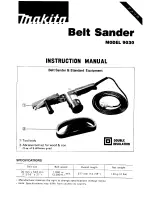
EN
35
part of the sander may result in personal injury.
• Do not overreach. Keep a proper footing and balance at all times. This enables better control of the
sander in unexpected situations.
• Dress appropriately. Do not wear loose-fitting clothes or jewellery. Keep your hair, clothing and gloves
away from moving parts. Loose clothes, jewellery or long hair can be caught in moving parts.
• If dust extraction and dust collection equipment is available, this should be connected and used
correctly. This type of equipment reduces the risk of problems caused by dust.
• Use a face mask that is designed for work in dusty environments. WARNING! Dust caused by sanding,
sawing, drilling and other similar operations may contain chemicals known to cause cancer, birth
defects and other genetic disorders. The following chemicals may be hazardous:
– Lead from lead-based paints.
– Silicon dioxide from bricks, cement and similar products.
– Arsenic and chromium from chemically treated lumber.
• The risk of exposure depends on how often this type of work is carried out. Mitigate the risks by
working in a well-ventilated area and use approved protective equipment, e.g. a face mask specifically
designed to filter out microscopic particles.
Operation and care of power tools
• Do not force the sander. Use the correct tool for the planned work. The sander will work better and be
safer with the load for which it is designed.
• Do not use the sander if it cannot be turned on and off using the power switch. Any power tool that
cannot be controlled with the switch is dangerous and must be repaired.
• Disconnect the power cable before making any adjustments, replacing accessories or putting the
sander into storage. Such preventive safety measures reduce the risk of starting the sander
accidentally.
• Keep power tools that are not in use stored out of the reach of children. Never let children or persons
unfamiliar with the sander or who have not read these instructions operate it. Power tools are
dangerous if they are used by inexperienced people.
• Maintain the sheet sander. Check that moving parts are correctly adjusted and move freely, that no
parts are incorrectly mounted or broken and that there are no other factors that can affect how it
works. If the sander is damaged, it must be repaired or replaced before being used again. Many
accidents are caused by poorly maintained power tools.
• Keep cutting tools sharp and clean. Properly maintained cutting tools with sharp cutting edges are
less likely to bind and are easier to control.
• Use the sander, accessories, etc. in accordance with these instructions, taking into account the
working conditions and the work that is to be carried out. It is dangerous to use power tools for
purposes other than those for which they are intended.
• Use the insulated gripping surfaces to hold the sander when performing an operation where the tool
could come into contact with live wires or its own power cable. Contact with a live cable also causes
the metal parts of the sander to become live and give the user an electric shock.
Содержание 010-089
Страница 44: ......










































